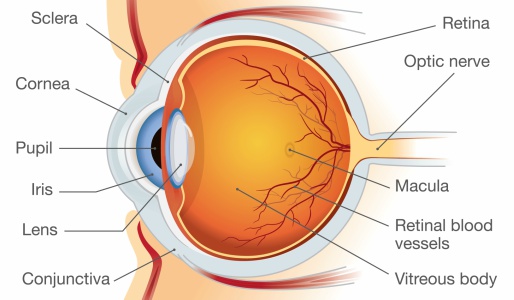Retinal Vein Occlusion and Diabetes
Retinal Vein Occlusion – What is it
A retinal vein occlusion occurs when one of the veins (or blood vessels) in the retina, becomes blocked. It’s sometimes referred to as an “eye stroke.”
Depending on the severity and location of the blockage, a retinal vein occlusion may lead to varying degrees of vision loss.
What is your retina – Your retina converts light and images into nerve signals and sends them to your brain via the optic nerve so you can see.
Normal retina function is impaired when blood flow is disrupted or blocked in the retinal veins.
EYE ANATOMY

Patients with diabetes
Patients with diabetes are potentially more susceptible to complications that may damage the retinas ability to send signals to brain necessary for vision. Potential eye complications from diabetes may include:
-
- Retinal haemorrhages
- Aneurysm – Swelling or bulge in the wall of a blood vessel
- Leakage of fluids and proteins from the fragile retinal blood vessels
- Cotton wool spots – Tiny white areas on the retina caused by a lack of blood flow
- Abnormal growth of blood vessels in the eye
- Hard exudates – Fatty lipids that are left behind after past macular swelling subsides.
POTENTIAL EYE COMPLICATIONS FROM DIABETES

Symptoms of Retinal Vein Occlusion
Symptom of retinal vein occlusion may include:
-
- Blurring or loss of vision that’s usually sudden in onset and generally in only one eye.
- Dark spots or floaters – Tiny clumps of cells or material floating in your eye.
- Build up of pressure causing pain in your eye.
If it isn’t treated, the blurring or loss of vision usually gets worse in hours or days. It’s important to see your doctor right away if you have these symptoms because a retinal vein occlusion may lead to further complications.
Retinal Vein Occlusion Treatments
Systemic risk factor reduction
Non-surgical treatments that may assist to help prevent further blockages include:
-
- Managing diabetes, high blood pressure, and high cholesterol levels
- Taking blood thinners recommended by your doctor.
Local eye treatment
Retinal vein occlusion may lead to further visual complications. Depending on the severity of your symptoms and diagnosis your doctor may recommend:
-
- Focal laser treatment, if macular edema is present
- Injections of anti-vascular endothelial growth factor (anti-VEGF) drugs into the eye.
- Laser treatment to prevent the growth of abnormal new leaky blood vessels that can cause haemorrhage (bleed) inside the eye and glaucoma
- Laser treatment to create bypass shunt between retina and choroid in selected cases with high fluid pressure.
WA Eye Specialists
There are a number of conditions that may cause a blockage of a retinal vein. Your doctor will undertake a thorough diagnosis and explain the treatment options available to your specific symptoms.
It’s important to see your doctor immediately if you display any of the symptoms described, as a retinal vein occlusion may lead to other complications and health problems.
If you have any questions about Retinal Vein Occlusion or would like to book an appointment please:
Retinal Vein Occlusion
Our specialist eye doctors see patients from all over Western Australia. They have extensive experience in the diagnosis and treatment of a wide range of eye conditions including Retinal Vein Occlusion. WA Eye Specialists have four practices located in Perth in Armadale, Joondalup, Midland, Murdoch and South Perth.

